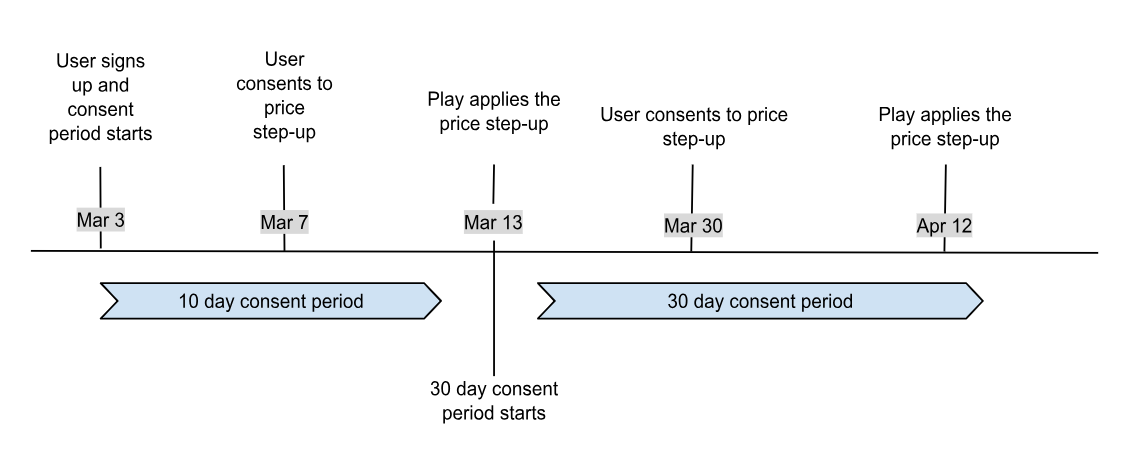คุณสามารถเปลี่ยนราคาของแพ็กเกจเริ่มต้นและข้อเสนอของการสมัครใช้บริการได้ ตัวอย่างเช่น คุณอาจมีผลิตภัณฑ์ดิจิทัลที่ต้องปรับราคาประจำปี หรือคุณอาจเปลี่ยนชุดสิทธิประโยชน์สำหรับผลิตภัณฑ์และต้องการแสดงการเปลี่ยนแปลงเหล่านี้ในราคา
ดูข้อมูลเพิ่มเติมเกี่ยวกับการเปลี่ยนราคาการสมัครใช้บริการโดยใช้ Play Console ได้ที่เอกสารประกอบในศูนย์ช่วยเหลือของ Play Console
หากต้องการเปลี่ยนราคาแพ็กเกจเริ่มต้นของการสมัครใช้บริการแบบเป็นโปรแกรม ให้ใช้วิธีการ
monetization.subscriptions.patch
เมธอดนี้รับออบเจ็กต์
Subscription
ที่มีการกำหนดค่าผลิตภัณฑ์การสมัครใช้บริการที่กำลังเปลี่ยนแปลง กำหนดราคาใหม่ในออบเจ็กต์
RegionalBasePlanConfig
ภายใต้แพ็กเกจเริ่มต้นที่ถูกต้องในคอลเล็กชัน basePlans ของการสมัครใช้บริการ
ซึ่งจะเป็นประโยชน์อย่างมากหากคุณมีแคตตาล็อกขนาดใหญ่และต้องการอัปเดตผลิตภัณฑ์ทั้งหมดในระยะเวลาอันสั้น หรือหากคุณมีระบบจัดการแคตตาล็อกผลิตภัณฑ์ที่ทำการเปลี่ยนแปลงผลิตภัณฑ์การสมัครใช้บริการใน Google Play โดยอัตโนมัติเมื่อมีการเปลี่ยนแปลง
คุณอาจต้องไปที่บันทึกการเปลี่ยนแปลงของ Play Console เพื่อค้นหาข้อมูลเกี่ยวกับการเปลี่ยนแปลงราคาที่คุณเคยทำในอดีต ข้อมูลที่คุณดูได้ในส่วนนี้รวมถึงเวลาที่อัปเดตราคา ผู้ที่เริ่มการเปลี่ยนแปลง ภูมิภาคที่อัปเดต และอื่นๆ ซึ่งอาจช่วยคุณในกรณีที่คุณต้องตรวจสอบการเปลี่ยนแปลงราคาที่ผ่านมาหรือตรวจสอบการเปลี่ยนแปลงราคาโดยไม่ตั้งใจเพื่อประเมินขั้นตอนถัดไป
การเปลี่ยนแปลงราคาสำหรับการซื้อการสมัครใช้บริการใหม่
เมื่อคุณเปลี่ยนแปลงราคาของแพ็กเกจเริ่มต้นหรือข้อเสนอ ราคาใหม่จะมีผลภายใน 2-3 ชั่วโมงสำหรับการซื้อใหม่ทั้งหมดโดยที่คุณไม่ต้องดำเนินการใดๆ เพิ่มเติม
การเปลี่ยนแปลงราคาสำหรับสมาชิกปัจจุบัน
เมื่อคุณเปลี่ยนราคาการสมัครใช้บริการ ผู้สมัครใช้บริการเดิมจะไม่ได้รับผลกระทบโดยค่าเริ่มต้น ระบบจะจัดให้ผู้สมัครใช้บริการเดิมอยู่ในกลุ่มประชากรตามรุ่นราคาเดิม ซึ่งจะยังคงชำระเงิน ในราคาแพ็กเกจเริ่มต้นเดิมเมื่อต่ออายุ
หากต้องการ คุณสามารถย้ายผู้สมัครใช้บริการเดิมไปยังราคาแพ็กเกจเริ่มต้นปัจจุบันได้ การดำเนินการนี้เรียกว่าการสิ้นสุดกลุ่มประชากรตามรุ่นสำหรับราคาเดิม การเปลี่ยนแปลงระยะการกำหนดราคาของข้อเสนอจะใช้กับสมาชิกปัจจุบันไม่ได้ สำหรับการสมัครใช้บริการแบบผ่อนชำระ การเปลี่ยนแปลงราคาสำหรับกลุ่มเดิมจะมีผลเมื่อสิ้นสุดระยะเวลาผูกมัดที่ใช้งานอยู่ คุณไม่สามารถเปลี่ยนราคาที่ผู้ใช้ชำระอยู่ในปัจจุบัน หากผู้ใช้กำลังชำระเงินแบบผ่อนชำระ
สิ้นสุดกลุ่มประชากรตามรุ่นสำหรับราคาเดิม
คุณเลือกสิ้นสุดกลุ่มราคาเดิมได้ทุกเมื่อ ซึ่งทำได้ แยกกันสำหรับแต่ละภูมิภาค หากต้องการสิ้นสุดราคาเดิมผ่าน Play Console โปรดดูศูนย์ช่วยเหลือของ Play Console
สิ้นสุดกลุ่มประชากรตามรุ่นสำหรับราคาเดิมด้วย Google Play Developer API
หากต้องการสิ้นสุดกลุ่มประชากรตามรุ่นสำหรับราคาเดิมโดยอัตโนมัติ ให้ใช้วิธี
monetization.subscriptions.basePlans.migratePrices
วิธีนี้จะย้ายข้อมูลสมาชิกที่ได้รับราคาการสมัครใช้บริการเดิมไปยังราคาแพ็กเกจเริ่มต้นปัจจุบันสำหรับภูมิภาคที่ระบุ นอกจากนี้
เมธอดจะทริกเกอร์การแจ้งเตือนการเปลี่ยนแปลงราคาให้ส่งไปยังผู้ใช้ที่
ปัจจุบันได้รับราคาในอดีตที่เก่ากว่าการประทับเวลาที่ระบุ เมื่อส่งคำขอนี้ คุณจะต้องใส่รายการออบเจ็กต์ RegionalPriceMigrationConfig
ในเนื้อหาคำขอเพื่อกำหนดค่าการย้ายข้อมูลกลุ่มประชากรตามรุ่นของราคา
ดูข้อมูลเพิ่มเติมเกี่ยวกับการใช้กลุ่มราคาเดิมได้ที่ศูนย์ช่วยเหลือของ Play Console
ราคาลดลง
เมื่อคุณสิ้นสุดกลุ่มประชากรตามรุ่นราคาเดิมและราคาซื้อใหม่ต่ำกว่า ราคาที่ผู้ใช้ในกลุ่มประชากรตามรุ่นจ่าย Google Play จะแจ้งให้ผู้ใช้ทราบทาง อีเมล และสมาชิกเหล่านี้จะเริ่มจ่ายเงินในราคาที่ต่ำลงในครั้งถัดไปที่ชำระเงิน สำหรับแพ็กเกจเริ่มต้น
หมายเหตุ: ระบบอาจกันวงเงินสำหรับการชำระเงินไว้ชั่วคราวนานสูงสุด 48 ชั่วโมงก่อนเริ่มระยะเวลาการต่ออายุถัดไปของผู้ใช้ อย่างไรก็ตาม สำหรับผู้ใช้ในอินเดียหรือบราซิล ระยะเวลานี้จะขยายเป็นสูงสุด 5 วันก่อนระยะเวลาการต่ออายุถัดไป ระบบจะไม่เก็บเงินในราคาที่ต่ำกว่าทันทีจากผู้ใช้ที่เคยได้รับอนุญาตในราคาที่สูงกว่า แต่จะต่ออายุในราคาที่ต่ำกว่าในการต่ออายุครั้งถัดไป
ผู้ทดสอบใบอนุญาตจะได้รับการแจ้งเตือนทางอีเมล เมื่อมีการปรับลดราคาด้วย
การขึ้นราคา
เมื่อสิ้นสุดกลุ่มประชากรตามรุ่นราคาเดิมและราคาใหม่สูงกว่าราคาที่ผู้ใช้ในกลุ่มประชากรตามรุ่นจ่ายอยู่ จะมีการขึ้นราคา การขึ้นราคา อาจกำหนดให้ผู้ใช้ดำเนินการหรือไม่ก็ได้
โดยค่าเริ่มต้น การปรับขึ้นราคาจะเป็นการเปลี่ยนแปลงแบบเลือกรับสำหรับสมาชิกปัจจุบัน ผู้ใช้ ต้องยอมรับราคาที่สูงขึ้นอย่างชัดเจนก่อนที่จะมีการเรียกเก็บเงินครั้งแรก ไม่เช่นนั้น Google Play จะยกเลิกการสมัครใช้บริการโดยอัตโนมัติ ระบบจะเรียกเก็บเงินจากผู้ใช้ในราคาที่สูงขึ้น ในครั้งถัดไปที่ผู้ใช้ชำระเงินสำหรับแพ็กเกจพื้นฐานหลังจากระยะเวลาการแจ้งเตือนล่วงหน้า 37 วัน Play จะแจ้งให้สมาชิกปัจจุบันทราบทางอีเมลและข้อความ Push 30 วันก่อนการเรียกเก็บเงินนี้
ในช่วง 7 วันแรกหลังจากที่ระบบทริกเกอร์การย้ายข้อมูลกลุ่มประชากรตามรุ่น จะไม่มีผู้ใช้ ได้รับการแจ้งเตือนจาก Google Play ซึ่งหมายความว่าคุณมีเวลา 7 วันนับจาก วันที่เริ่มเลือกใช้การขึ้นราคาในการแจ้งเตือนสมาชิกปัจจุบัน ก่อนที่ Google Play จะเริ่มแจ้งเตือนสมาชิกโดยตรง ในช่วงนี้ คุณสามารถยกเลิกการขึ้นราคาที่รอดำเนินการได้อย่างมีประสิทธิภาพโดยการเปลี่ยนราคากลับไปเป็นราคาเดิมอีกครั้ง
หลังจากช่วง 7 วันดังกล่าว ผู้ใช้แต่ละรายจะได้รับการแจ้งเตือนอัตโนมัติจาก Google Play 30 วันก่อนการต่ออายุครั้งแรกในราคาใหม่
ในบางกรณีเมื่อขึ้นราคาสำหรับผู้สมัครใช้บริการปัจจุบัน คุณจะมี ตัวเลือกในการขึ้นราคาโดยแจ้งให้ผู้ใช้ทราบล่วงหน้า แต่ ไม่ต้องกำหนดให้ผู้ใช้ดำเนินการใดๆ ด้วยตัวเลือกนี้ เว้นแต่ผู้ใช้จะเลือกไม่รับโดยการเปลี่ยนแพ็กเกจการสมัครใช้บริการหรือยกเลิกการสมัครใช้บริการ ระบบจะเรียกเก็บเงินตามราคาใหม่จากผู้ใช้ในครั้งถัดไปที่ชำระเงินสำหรับแพ็กเกจเริ่มต้น หลังจากระยะเวลาการแจ้งเตือนล่วงหน้า ระยะเวลานี้จะแตกต่างกันไปในแต่ละประเทศและอาจเป็น 30 วันหรือ 60 วัน Play จะแจ้งให้สมาชิกปัจจุบันทราบทางอีเมลและข้อความ Push ในช่วงจำนวนวันก่อนการเรียกเก็บเงินนี้
การขึ้นราคาแบบไม่ได้ขอให้ผู้ใช้ยินยอมมีให้บริการเฉพาะในบางพื้นที่ โดยมีการจำกัด จำนวนเงินและความถี่ในการขึ้นราคา และเป็นไปตามข้อกำหนดบางอย่างสำหรับนักพัฒนาแอป
คุณสามารถทำเครื่องหมายการย้ายข้อมูลกลุ่มราคาเดิมเป็นการขึ้นราคาแบบไม่ได้ขอให้ผู้ใช้ยินยอมได้หากเป็นไปตามเกณฑ์เหล่านั้น ดังที่แสดงในรูปที่ 1
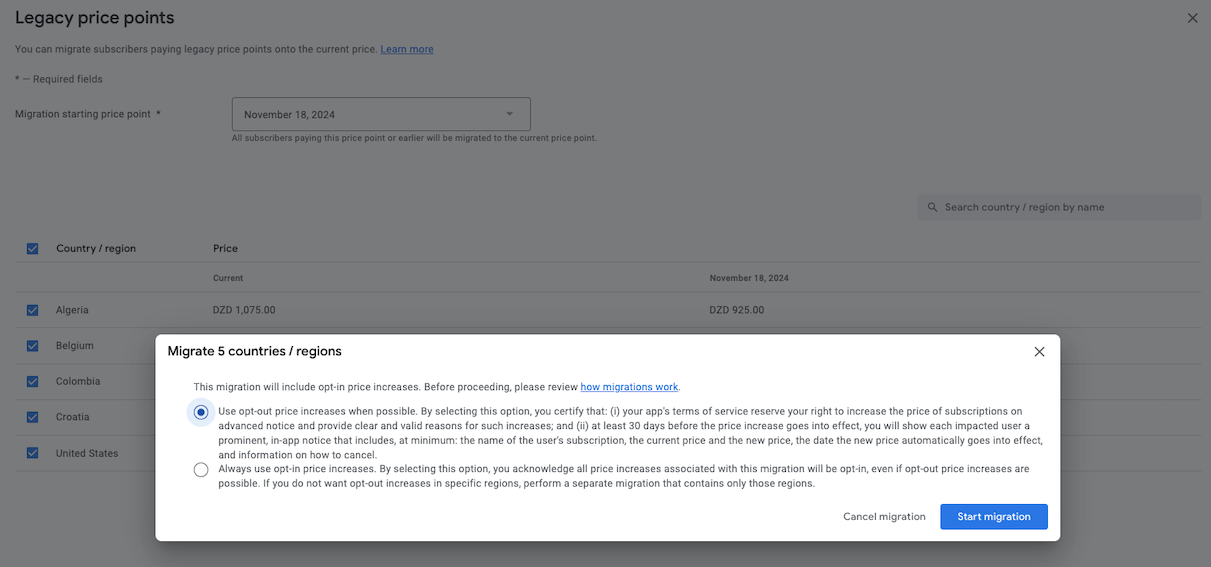

แจ้งการเปลี่ยนแปลงราคาให้ผู้ใช้ทราบ
คุณควรแจ้งให้สมาชิกปัจจุบันทราบทุกครั้งที่สิ้นสุดกลุ่มราคาเดิม
สำหรับการขึ้นราคาแบบไม่ได้ขอให้ผู้ใช้ยินยอม คุณควรแจ้งให้ผู้ใช้ทราบล่วงหน้า และต้องแสดงประกาศในแอปต่อผู้ใช้ การขึ้นราคาแบบขอให้ผู้ใช้ยินยอมจะไม่มีระยะเวลารอ 7 วันก่อนที่ Play จะเริ่มแจ้งเตือนผู้ใช้โดยตรง
สำหรับการขึ้นราคาแบบขอให้ผู้ใช้ยินยอม ให้แจ้งเตือนผู้ใช้ล่วงหน้าและแจ้งให้ทราบถึง ความจำเป็นในการยอมรับการขึ้นราคา เมื่อเริ่มเลือกใช้การขึ้นราคา คุณจะมีเวลา 7 วันในการแจ้งให้สมาชิกปัจจุบันทราบก่อนที่ Google Play จะเริ่มแจ้งให้สมาชิกทราบโดยตรง เราขอแนะนำให้คุณแจ้งให้ผู้ใช้ที่ได้รับผลกระทบทราบ ในแอปของคุณ และระบุ Deep Link ไปยังหน้าจอการสมัครใช้บริการ Play Store เพื่อ ช่วยให้ผู้ใช้ตรวจสอบราคาใหม่ได้อย่างง่ายดาย เมื่อผู้ใช้ตรวจสอบการเลือกใช้การขึ้นราคา ในหน้าจอการสมัครใช้บริการของ Play Store ระบบจะแสดงกล่องโต้ตอบที่คล้ายกับรูปที่ 2
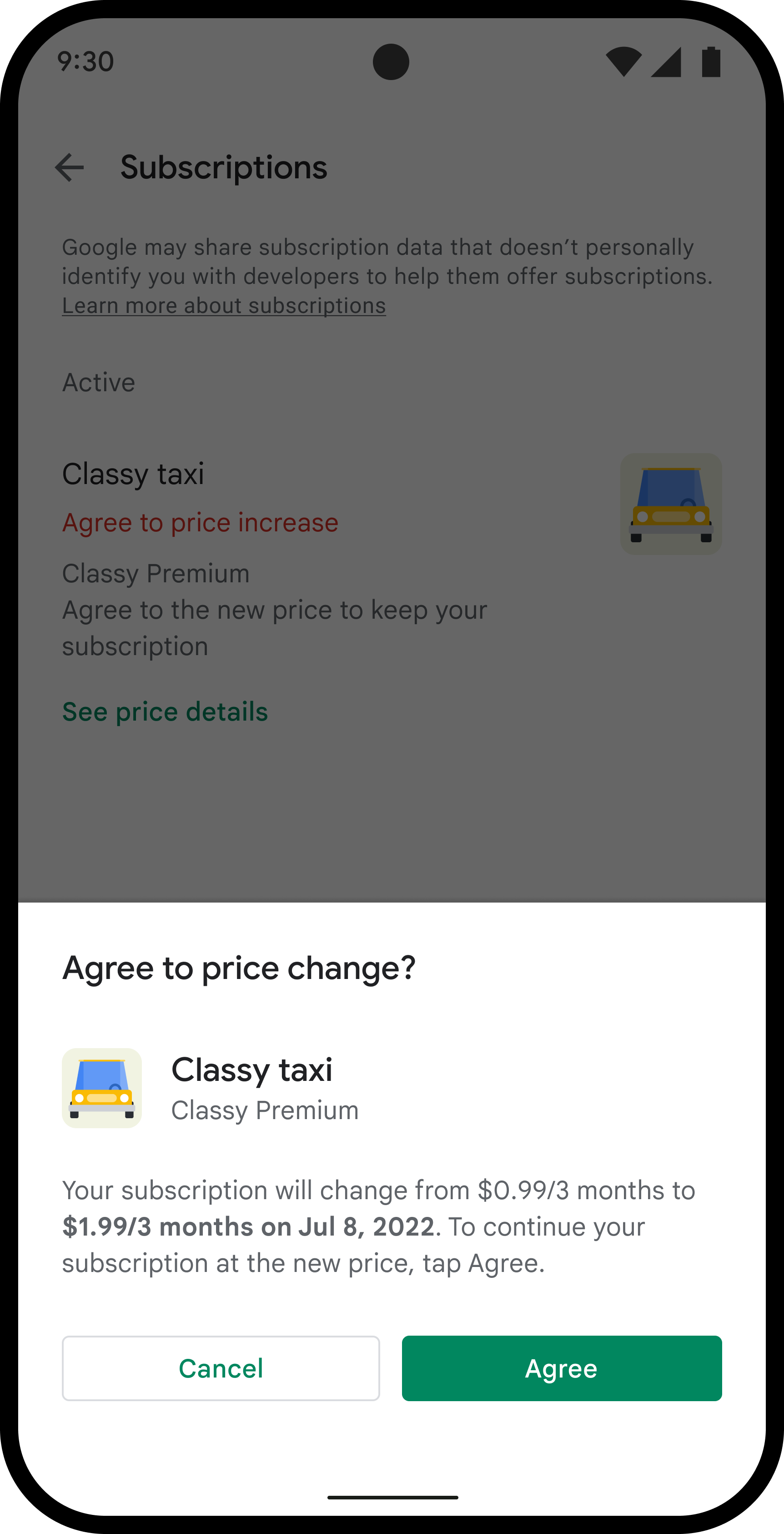
จัดการการตอบกลับของผู้ใช้ต่อการเปลี่ยนแปลงราคาแบบขอให้ผู้ใช้ยินยอม
หลังจากที่คุณแจ้งให้สมาชิกปัจจุบันทราบถึงการเปลี่ยนแปลงราคาและเป็นการขึ้นราคาแบบขอให้ผู้ใช้ยินยอมแล้ว สมาชิกอาจดำเนินการก่อนที่ราคาใหม่จะมีผลเพื่อยอมรับหรือไม่ยอมรับการขึ้นราคา หากมีการดำเนินการ คุณจะได้รับ RTDN ที่แจ้งผลลัพธ์ให้ทราบ ดูวิธีจัดการการแจ้งเตือนเหล่านี้ได้ในคำแนะนำเกี่ยวกับวงจรการซื้อ
หากผู้ใช้ไม่ดำเนินการใดๆ และถึงการต่ออายุครั้งแรกที่จะมีการใช้ราคาแบบเลือกใช้ ระบบจะยกเลิกการสมัครใช้บริการโดยอัตโนมัติและจะหมดอายุในวันที่ต่ออายุนั้น
การขึ้นราคาโดยไม่ตั้งใจ
ส่วนนี้อธิบายสถานการณ์ต่างๆ ในการจัดการการเปลี่ยนแปลงราคาที่เกิดขึ้นโดยไม่ตั้งใจ
การขึ้นราคาแบบขอให้ผู้ใช้ยินยอม - หากคุณเริ่มการขึ้นราคาแบบขอให้ผู้ใช้ยินยอมโดยไม่ได้ตั้งใจ ให้ย้อนกลับการเปลี่ยนแปลงทันทีโดยเปลี่ยนราคาอีกครั้งกลับไปเป็นราคาเดิม
เปลี่ยนราคาราคาแพ็กเกจเริ่มต้นกลับไปเป็นราคาเดิม แล้วไปที่หน้าจุดราคาเดิมเพื่อเริ่มลดราคาเป็นราคาเดิม สมาชิกปัจจุบันจะไม่ได้รับการแจ้งเตือนเกี่ยวกับการเปลี่ยนแปลงราคาโดยไม่ตั้งใจ หากมีการเปลี่ยนราคากลับภายใน 7 วัน หากมีการเปลี่ยนกลับไปใช้ราคาเดิมหลังจากผ่านไป 7 วัน ระบบจะยกเลิกการเปลี่ยนแปลงราคา สำหรับผู้ใช้ที่ยังไม่ได้ชำระเงินในราคาใหม่ การเปลี่ยนแปลงราคาจะถูกยกเลิก หลังจากระยะเวลาการให้สิทธิ์ชำระเงินสูงสุด 5 วัน ผู้ใช้บางรายอาจได้รับประกาศทางอีเมลเกี่ยวกับการเลือกใช้แล้ว โดยอิงตามวันที่ต่ออายุ
การขึ้นราคาแบบไม่ได้ขอให้ผู้ใช้ยินยอม - คุณยกเลิกการขึ้นราคาแบบไม่ได้ขอให้ผู้ใช้ยินยอมที่เกิดขึ้นโดยไม่ตั้งใจได้โดย เปลี่ยนราคากลับไปเป็นราคาเดิม เปลี่ยนราคาแพ็กเกจเริ่มต้น กลับไปเป็นราคาเดิม แล้วไปที่หน้าจุดราคาเดิมเพื่อ เริ่มลดราคาเป็นราคาเดิม หากผู้ใช้ยังไม่ได้ชำระเงินในราคาที่สูงขึ้น การขึ้นราคาจะถูกยกเลิกหลังจากระยะเวลาการให้สิทธิ์การชำระเงินนานสูงสุด 5 วัน ทั้งนี้ขึ้นอยู่กับเวลาที่ระบบเปลี่ยนกลับราคา ผู้ใช้บางรายอาจได้รับอีเมลแจ้งเตือนการขึ้นราคาแล้ว ทั้งนี้ขึ้นอยู่กับวันที่ต่ออายุ
การลดราคา - คุณยกเลิกการลดราคาได้โดยเปลี่ยนราคาสมัครใช้บริการกลับไปเป็นราคาเดิมโดยใช้ Google Play Console เปลี่ยนราคาราคาของแพ็กเกจเริ่มต้นกลับไปเป็นราคาเดิม แล้วไปที่หน้าจุดราคาเดิมเพื่อเริ่มการขึ้นราคาเป็นราคาเดิม นักพัฒนาแอปสามารถเริ่มการเลือกรับหรือเลือกไม่รับ (หากมีสิทธิ์) เพื่อยกเลิกการลดราคา หากใช้การเลือกไม่ใช้ ระบบจะนับรวม ในการคำนวณความถี่ Google Play จะพิจารณาว่าการยกเลิกมีผลต่อการต่ออายุครั้งถัดไปของผู้ใช้หรือไม่ โดยอิงตาม ช่วงเวลาของการเปลี่ยนกลับนี้เมื่อเทียบกับวันที่ต่ออายุของผู้ใช้แต่ละราย
การยกเลิกเนื่องจากราคาลดจะมีผลหากระยะเวลาระหว่างการเปลี่ยนราคากลับไปเป็นราคาเดิมกับเวลาต่ออายุที่ผู้ใช้คาดไว้ในราคาใหม่นั้นนานกว่าระยะเวลาการแจ้งเตือนที่เกี่ยวข้องของแต่ละประเทศ (30 หรือ 60 วัน) การต่ออายุการสมัครใช้บริการครั้งถัดไปของผู้ใช้ จะเกิดขึ้นในราคาเดิมที่สูงกว่า
การยกเลิกเนื่องจากราคาลดจะใช้ไม่ได้หากระยะเวลาระหว่างการเปลี่ยนราคากลับไปเป็นราคาเดิมกับเวลาต่ออายุที่คาดไว้ของผู้ใช้ในราคาใหม่สั้นกว่าหรือเท่ากับระยะเวลาการแจ้งเตือนที่เกี่ยวข้องของแต่ละประเทศ (30 หรือ 60 วัน) แต่ผู้ใช้จะเข้าสู่กระบวนการขึ้นราคาหลังจากที่ระบบเรียกเก็บเงินในราคาที่ต่ำกว่าอย่างน้อย 1 ครั้งเมื่อต่ออายุครั้งถัดไป จากนั้นผู้ใช้จะได้รับการแจ้งเตือนเกี่ยวกับการขึ้นราคา ผู้ใช้จะต้องยอมรับการขึ้นราคาสำหรับการขึ้นราคาแบบขอให้ผู้ใช้ยินยอม หรือจะได้รับการแจ้งเตือนเกี่ยวกับการขึ้นราคาแบบไม่ได้ขอให้ผู้ใช้ยินยอม ทั้งนี้ขึ้นอยู่กับโหมดที่เลือกไว้ในระหว่างการย้ายข้อมูลราคา ในกรณีนี้ ข้อจำกัดด้านความถี่และจำนวนสำหรับการเลือกไม่ใช้การเพิ่มจะยังคงมีผล
จัดการการเปลี่ยนแปลงราคาที่ทับซ้อนกัน
โปรดเปลี่ยนแปลงราคาทีละรายการเท่านั้น อย่างไรก็ตาม หากคุณเปลี่ยนแปลงราคาหลายครั้ง ผู้ใช้ที่ได้รับผลกระทบจะต้องยอมรับเฉพาะการเปลี่ยนแปลงราคาครั้งล่าสุดเท่านั้น ตัวอย่างเช่น หากคุณสิ้นสุดกลุ่มประชากรตามรุ่นที่ใช้ราคาเดิม ด้วยการขึ้นราคาแบบขอให้ผู้ใช้ยินยอม เปลี่ยนแปลงราคาอีกครั้ง แล้วขึ้นราคาแบบขอให้ผู้ใช้ยินยอมอีกครั้ง ผู้ใช้ที่ได้รับผลกระทบไม่จำเป็นต้องดำเนินการใดๆ กับการขึ้นราคาครั้งแรก เนื่องจากมีเพียงการขึ้นราคาครั้งที่ 2 เท่านั้นที่มีผล ลักษณะการทำงานนี้มีผลกับการขึ้นและการลดราคาจากราคาเดิม ทั้งแบบขอให้ผู้ใช้ยินยอมและแบบไม่ได้ขอให้ผู้ใช้ยินยอม
เมื่อคุณเริ่มการย้ายข้อมูลราคาใหม่สำหรับไอเทมที่มีการย้ายข้อมูลราคาที่เก่ากว่าซึ่งกำลังดำเนินการอยู่ Google Play จะจัดการดังนี้
ยกเลิกการย้ายข้อมูลราคาเดิมแล้ว
Google Play จะหยุดการย้ายข้อมูลราคาเดิม ใน
SubscriptionPurchaseV2API คุณจะเห็นรายละเอียดการเปลี่ยนแปลงราคาเดิมที่ทำเครื่องหมายเป็นCANCELEDนอกจากนี้ คุณยังจะ ได้รับSUBSCRIPTION_PRICE_CHANGE_UPDATEDRTDN ด้วยการย้ายข้อมูลราคาใหม่จะเริ่มขึ้น
หลังจากนั้น Google Play จะเริ่มย้ายข้อมูลราคาใหม่ทันที โดยจะปรากฏใน
SubscriptionPurchaseV2เป็นOUTSTANDING(สำหรับการขึ้นราคาแบบขอให้ผู้ใช้ยินยอม) หรือCONFIRMED(สำหรับการขึ้นราคาแบบไม่ได้ขอให้ผู้ใช้ยินยอมหรือการลดราคา) คุณจะได้รับ RTDN อีกรายการสำหรับไอเทมSUBSCRIPTION_PRICE_CHANGE_UPDATEDผู้ใช้จะได้รับราคาใหม่
ตอนนี้ระบบจะย้ายผู้ใช้ไปยังการย้ายข้อมูลราคาใหม่ และผู้ใช้จะไม่ ทำการเปลี่ยนราคาครั้งก่อนให้เสร็จสมบูรณ์ และผู้ใช้จะได้รับ ระยะเวลาการแจ้งเตือนมาตรฐานสำหรับราคาใหม่
ทดสอบการเปลี่ยนแปลงราคา
อย่าเปลี่ยนราคาการสมัครใช้บริการสำหรับผลิตภัณฑ์ที่สมาชิกที่ใช้งานอยู่เป็นเจ้าของเพื่อวัตถุประสงค์ในการทดสอบ
คุณใช้แอป Play Billing Lab และผู้ทดสอบที่มีใบอนุญาตเพื่อทดสอบการเปลี่ยนแปลงราคาค่าสมัครใช้บริการได้โดยไม่ส่งผลกระทบต่อสมาชิกรายอื่นๆ ที่ใช้งานอยู่
ดูข้อมูลเพิ่มเติมเกี่ยวกับการทดสอบการเปลี่ยนแปลงราคาได้จากคำแนะนำในการทดสอบ
ตัวอย่าง
ตัวอย่างในส่วนนี้แสดงวิธีใช้แนวทางปฏิบัติแนะนำใน สถานการณ์การเปลี่ยนแปลงราคาต่างๆ
ตัวอย่างการขึ้นราคาแบบขอให้ผู้ใช้ยินยอม
ตัวอย่างที่ 1: การขึ้นราคาแบบขอให้ผู้ใช้ยินยอมสำหรับการสมัครใช้บริการรายเดือน
ในวันที่ 3 มีนาคม AltoStrat จะขึ้นราคา AltoStrat Pro ซึ่งเป็นแพ็กเกจ การสมัครใช้บริการสตรีมมิงวิดีโอแบบพรีเมียม โดยจะสิ้นสุดการใช้ราคาเดิมสำหรับกลุ่มประชากรตามรุ่น โดยจะย้ายผู้ใช้ ในกลุ่มประชากรตามรุ่นราคาเดิมที่ $1 ไปยังราคาแพ็กเกจเริ่มต้นปัจจุบันที่ $2 วันที่การเปลี่ยนแปลงราคาจะมีผลคือวันที่ 9 เมษายน (37 วันหลังจากวันที่ 3 มีนาคม)
อลิซเป็นสมาชิกปัจจุบันที่มีกำหนดต่ออายุครั้งถัดไปในวันที่ 5 มีนาคม การต่ออายุครั้งแรกหลังจากวันที่ราคาใหม่มีผลคือวันที่ 5 พฤษภาคม ดังนั้นเธอจึงต่ออายุในวันที่ 5 มีนาคมและวันที่ 5 เมษายนในราคาเดิม ($1) เมื่อต่ออายุอีกครั้งในวันที่ 5 พฤษภาคม ระบบจะเรียกเก็บเงินจากเธอในราคาใหม่ ($2) Google Play เริ่มแจ้งเตือนอลิซเรื่องการเปลี่ยนแปลงราคาในวันที่ 5 เมษายน ซึ่งเป็นเวลา 30 วันก่อนวันที่ต่ออายุครั้งแรกที่มีราคาใหม่

บ็อบเป็นสมาชิกปัจจุบันที่มีการต่ออายุครั้งถัดไปในวันที่ 29 มีนาคม เขาต่ออายุในวันที่ 29 มีนาคมในราคาเดิม ($1) เนื่องจาก การเปลี่ยนแปลงราคายังไม่มีผล เมื่อต่ออายุอีกครั้งในวันที่ 29 เมษายน ระบบจะเรียกเก็บเงินจากเขาในราคาใหม่ ($2) เขา เริ่มได้รับการแจ้งเตือนการเปลี่ยนแปลงราคาในวันที่ 30 มีนาคม ซึ่งเป็น 30 วันก่อน วันที่ต่ออายุครั้งแรกที่มีราคาใหม่

ตัวอย่างที่ 2: การขึ้นราคาแบบขอให้ผู้ใช้ยินยอมสำหรับการสมัครใช้บริการ 3 เดือน
ในวันที่ 3 มีนาคม FindMyLove จะสิ้นสุดกลุ่มรุ่นราคาเดิมและเพิ่มค่าธรรมเนียม 3 เดือน สำหรับ FindMyLove Premium จาก $1 เป็นราคาแพ็กเกจพื้นฐานที่ $2 วันที่ที่มีผล ของการเปลี่ยนแปลงราคาคือวันที่ 9 เมษายน (37 วันหลังจากวันที่ 3 มีนาคม)
อลิซเป็นสมาชิกปัจจุบันที่มีกำหนดต่ออายุครั้งถัดไปในวันที่ 5 มีนาคม อลิสต่ออายุ ในราคาเดิม ($1) เนื่องจากการเปลี่ยนแปลงราคายังไม่มีผล เมื่อต่ออายุอีกครั้งในวันที่ 5 มิถุนายน ระบบจะเรียกเก็บเงินจากเธอในราคาใหม่ ($2) เธอเริ่ม ได้รับการแจ้งเตือนเกี่ยวกับการเปลี่ยนแปลงราคาในวันที่ 6 พฤษภาคม ซึ่งเป็นเวลา 30 วันก่อน วันที่ต่ออายุครั้งแรกที่มีราคาใหม่

บ็อบเป็นสมาชิกปัจจุบันที่มีการต่ออายุครั้งถัดไปในวันที่ 11 เมษายน บ็อบต่ออายุในราคาใหม่ ($2) เนื่องจากเป็นการต่ออายุหลังจากวันที่การเปลี่ยนแปลงราคามีผล เขาเริ่มได้รับการแจ้งเตือนเกี่ยวกับการเปลี่ยนแปลงราคาในวันที่ 12 มีนาคม ซึ่งเป็นเวลา 30 วันก่อนวันที่ต่ออายุครั้งแรกที่มีราคาใหม่

ตัวอย่างที่ 3: การขึ้นราคาแบบขอให้ผู้ใช้ยินยอมสำหรับการสมัครใช้บริการรายสัปดาห์
ในวันที่ 3 มีนาคม CutePetsNews จะสิ้นสุดกลุ่มราคาเดิม ซึ่งจะทําให้เกิดการย้ายข้อมูลราคา ของค่าธรรมเนียมรายสัปดาห์สําหรับการแจ้งเตือนเกี่ยวกับสุนัขรายสัปดาห์จาก $1 เป็น $2 การเปลี่ยนแปลงราคาจะมีผลในวันที่ 9 เมษายน
อลิซเป็นสมาชิกปัจจุบันที่มีการต่ออายุรายสัปดาห์ครั้งถัดไปในวันที่ 6 มีนาคม โดยจะต่ออายุในวันที่ 6, 13, 20, 27 มีนาคม และ 3 เมษายนในราคาเดิม ($1) เนื่องจากยังไม่มีการเปลี่ยนแปลงราคา เมื่อต่ออายุอีกครั้งในวันที่ 10 เมษายน ระบบจะเรียกเก็บเงินจากเธอในราคาใหม่ ($2) เธอเริ่มได้รับการแจ้งเตือน เกี่ยวกับการเปลี่ยนแปลงราคาในวันที่ 11 มีนาคม ซึ่งเป็น 30 วันก่อนวันที่ต่ออายุครั้งแรก ที่มีราคาใหม่

ตัวอย่างที่ 4: การสมัครใช้บริการรายเดือนที่มีการเปลี่ยนแปลงราคาแบบขอให้ผู้ใช้ยินยอมหลายครั้ง
ตัวอย่างนี้แสดงวิธีจัดการการเปลี่ยนแปลงราคาหลายรายการ
ในวันที่ 3 มีนาคม AltoStrat จะเริ่มการย้ายข้อมูลราคาสำหรับ AltoStrat Pro ซึ่งเป็น การสมัครใช้บริการวิดีโอพรีเมียม โดยจะขึ้นราคาจาก $1 เป็น $2 ต่อเดือน ในวันที่ 10 มีนาคม นักพัฒนาแอปจะทริกเกอร์การย้ายข้อมูลราคาครั้งที่ 2 ซึ่งจะเพิ่มราคาเป็น $3 ต่อเดือน
วันที่การเปลี่ยนแปลงราคาครั้งแรกจะมีผลคือวันที่ 9 เมษายน (37 วันหลังจากวันที่ 3 มีนาคม) วันที่การเปลี่ยนแปลงราคาครั้งที่ 2 มีผลคือวันที่ 16 เมษายน (37 วันหลังจากวันที่ 10 มีนาคม)
การต่ออายุครั้งถัดไปของอลิซคือวันที่ 5 มีนาคม การต่ออายุครั้งแรกหลังจากวันที่ราคาใหม่มีผล คือวันที่ 5 พฤษภาคม ดังนั้นเธอจึงต่ออายุในวันที่ 5 มีนาคมและ 5 เมษายนในราคาเดิม ($1) เมื่อต่ออายุอีกครั้งในวันที่ 5 พฤษภาคม ระบบจะเรียกเก็บเงินจากเธอในราคาล่าสุด ($3) เธอจะได้รับ การแจ้งเตือน เกี่ยวกับการเปลี่ยนแปลงราคาครั้งที่ 2 เท่านั้น เนื่องจากมีการเปลี่ยนแปลงราคา ภายในระยะเวลาหยุดชั่วคราว 7 วัน เธอเริ่มได้รับการแจ้งเตือนเกี่ยวกับการเปลี่ยนแปลงราคาในวันที่ 5 เมษายน ซึ่งเป็นเวลา 30 วันก่อนถึงวันที่ต่ออายุครั้งแรกที่มีราคาใหม่

ตัวอย่างที่ 5: การขึ้นราคาแบบขอให้ผู้ใช้ยินยอมสำหรับการสมัครใช้บริการแบบผ่อนชำระ 12 เดือน
ตัวอย่างนี้แสดงวิธีจัดการการขึ้นราคาสำหรับการสมัครใช้บริการแบบผ่อนชำระ
ในวันที่ 3 มีนาคม AltoStrat จะขึ้นราคา AltoStrat Pro ซึ่งเป็น การสมัครใช้บริการสตรีมมิงวิดีโอแบบพรีเมียม โดยจะสิ้นสุดการกำหนดราคาเดิมสำหรับกลุ่มประชากรตามรุ่น โดยจะ ย้ายผู้ใช้ในกลุ่มประชากรตามรุ่นราคาเดิมที่ราคา $1 ไปยังราคาแพ็กเกจเริ่มต้นปัจจุบันที่ $2 วันที่การเปลี่ยนแปลงราคาจะมีผลคือวันที่ 9 เมษายน (37 วันหลังจากวันที่ 3 มีนาคม)
อลิซเป็นสมาชิกปัจจุบันที่ลงชื่อสมัครใช้แพ็กเกจแบบผ่อนชำระ 12 เดือน และต่ออายุใหม่อัตโนมัติรายเดือนในวันที่ 10 มิถุนายนของปีก่อน การต่ออายุครั้งแรกของเธอคือวันที่ 10 มิถุนายนของปีปัจจุบัน เนื่องจากขวัญใจอยู่ระหว่าง การชำระเงินงวด เธอจึงชำระเงิน 30 บาทต่อไปในวันที่ 10 มีนาคม 10 เมษายน และ 10 พฤษภาคม โดยเธอจะต่ออายุครั้งแรกในวันที่ 10 มิถุนายน ซึ่งระบบจะเรียกเก็บเงินในราคาใหม่ ($2) และเปลี่ยนไปใช้การต่ออายุอัตโนมัติแบบรายเดือน Google Play เริ่ม แจ้งเตือนอลิซเรื่องการเปลี่ยนแปลงราคาในวันที่ 11 พฤษภาคม ซึ่งเป็นเวลา 30 วันก่อน วันที่ต่ออายุครั้งแรกด้วยราคาใหม่
ตัวอย่างการเปลี่ยนแปลงราคาแบบไม่ได้ขอให้ผู้ใช้ยินยอม
ตัวอย่างที่ 1: การเปลี่ยนแปลงราคาการเลือกไม่ใช้การสมัครใช้บริการรายเดือน
ตัวอย่างนี้แสดงวิธีจัดการการขึ้นราคาแบบไม่ได้ขอให้ผู้ใช้ยินยอม
AltoStrat จำเป็นต้องปรับราคาประจำปีเพื่อชดเชย ต้นทุนการเขียนโปรแกรมที่เพิ่มขึ้น ในวันที่ 2 มกราคม บริษัทได้เปลี่ยนราคาของ AltoStrat Pro (การสมัครใช้บริการสตรีมมิงวิดีโอแบบพรีเมียม) จาก $1 เป็น $1.30 การขึ้นราคานี้เป็นไปตามเกณฑ์สำหรับการย้ายข้อมูลราคาแบบไม่ได้ขอให้ผู้ใช้ยินยอม โดยจะ สิ้นสุดกลุ่มประชากรตามรุ่นสำหรับราคาเดิมทันที และระบุการย้ายข้อมูลแบบเลือกไม่รับ ผู้ใช้ ในกลุ่มประชากรตามรุ่นนี้อยู่ในภูมิภาคที่ต้องมีการแจ้งเตือนการเลือกไม่รับขั้นต่ำ 30 วัน ดังนั้นราคาใหม่จะมีผลในวันที่ 1 กุมภาพันธ์
อลิซเป็นสมาชิกปัจจุบันที่ระบบเรียกเก็บเงินในวันที่ 14 ของแต่ละเดือน เนื่องจาก ระยะเวลาการแจ้งเตือนขั้นต่ำ 30 วัน เธอจึงชำระเงินในราคาเดิม ($1) ในวันที่ 14 มกราคม Google Play เริ่มแจ้งเตือนอลิซเรื่องการเปลี่ยนแปลงราคาในวันที่ 15 มกราคม และอลิซ เริ่มชำระเงินในราคาใหม่ ($1.30) ในวันที่ 14 กุมภาพันธ์
ตัวอย่างความยินยอมในการเพิ่มราคา
ตัวอย่างความยินยอมในการปรับราคาขึ้น ในส่วนนี้ใช้ได้กับภูมิภาคเกาหลีใต้ (KR) เท่านั้น
ตัวอย่างที่ 1: ผู้ใช้ยินยอมให้มีการขึ้นราคาในระหว่างการลงชื่อสมัครใช้
วันที่ 3 มีนาคม ผู้ใช้ลงชื่อสมัครใช้บริการในเกาหลีใต้โดยมี ช่วงทดลองใช้ฟรี 10 วัน ผู้ใช้ยินยอมให้มีการขึ้นราคาในระหว่าง การลงชื่อสมัครใช้ ในกรณีนี้ Play จะปรับราคาขึ้นในวันที่ 13 มีนาคม
ตัวอย่างที่ 2: ผู้ใช้ไม่ยินยอมให้ขึ้นราคาในช่วงทดลองใช้ฟรี
วันที่ 3 มีนาคม ผู้ใช้ลงชื่อสมัครใช้บริการในเกาหลีใต้โดยมี ช่วงทดลองใช้ฟรี 10 วัน ผู้ใช้ไม่ยินยอมให้มีการปรับราคาขึ้น ระหว่างการลงชื่อสมัครใช้หรือช่วงทดลองใช้ฟรี ลำดับเหตุการณ์ในสถานการณ์นี้มีดังนี้
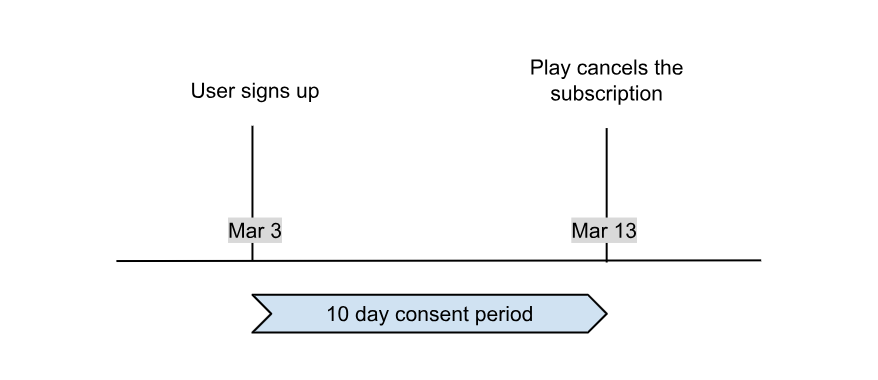
ตัวอย่างที่ 3: ผู้ใช้ยินยอมให้มีการปรับราคาขึ้นระหว่างช่วงทดลองใช้ฟรี
วันที่ 3 มีนาคม ผู้ใช้ลงชื่อสมัครใช้บริการในเกาหลีใต้โดยมี ช่วงทดลองใช้ฟรี 10 วัน ผู้ใช้ยินยอมให้มีการปรับราคาขึ้น ในระหว่างช่วงทดลองใช้ฟรี ลำดับเหตุการณ์ในสถานการณ์นี้มีดังนี้

ตัวอย่างที่ 4: ผู้ใช้ไม่ยินยอมให้เพิ่มราคาสำหรับข้อเสนอช่วงแนะนำ
ในวันที่ 3 มีนาคม ผู้ใช้ลงชื่อสมัครใช้บริการในเกาหลีใต้โดยมี ระยะเวลาของราคาแนะนำ 60 วัน ผู้ใช้ไม่ยินยอมให้ เพิ่มราคาในระหว่างการลงชื่อสมัครใช้ ลำดับของ เหตุการณ์ในสถานการณ์นี้มีดังนี้
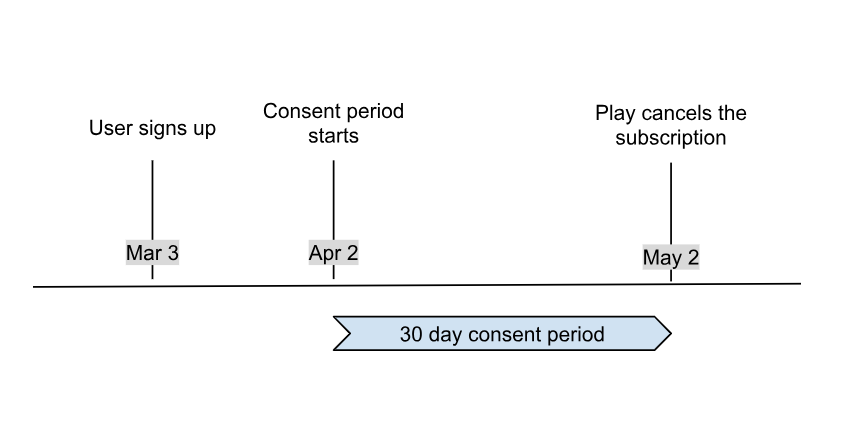
ตัวอย่างที่ 5: ผู้ใช้ยินยอมให้เพิ่มราคาในช่วง ช่วงทดลองใช้ฟรีและข้อเสนอช่วงแนะนำ
หากคุณเสนอการสมัครใช้บริการทั้งแบบทดลองใช้ฟรีและ ข้อเสนอช่วงแนะนำ Play จะขอความยินยอมจากผู้ใช้ในเหตุการณ์ต่อไปนี้
- ในช่วงทดลองใช้ฟรี Play จะขอความยินยอมจากผู้ใช้เพื่อ เปลี่ยนจากช่วงทดลองใช้ฟรีเป็นราคาช่วงแนะนำ
- หากผู้ใช้ให้ความยินยอมในช่วงทดลองใช้ฟรี ในช่วงระยะเวลาราคาช่วงแนะนำ Play จะขอความยินยอมจากผู้ใช้เพื่อเปลี่ยนจากราคาช่วงแนะนำเป็นราคาปกติ
ตัวอย่างเช่น ในวันที่ 3 มีนาคม ผู้ใช้ลงชื่อสมัครใช้บริการในเกาหลีใต้โดยมี ระยะทดลองใช้ฟรี 10 วันและระยะราคาช่วงแนะนำ 30 วัน ผู้ใช้ยินยอมให้มีการปรับราคาขึ้นระหว่างช่วงทดลองใช้ฟรี และข้อเสนอช่วงแนะนำ ลำดับเหตุการณ์ในสถานการณ์นี้มีดังนี้
